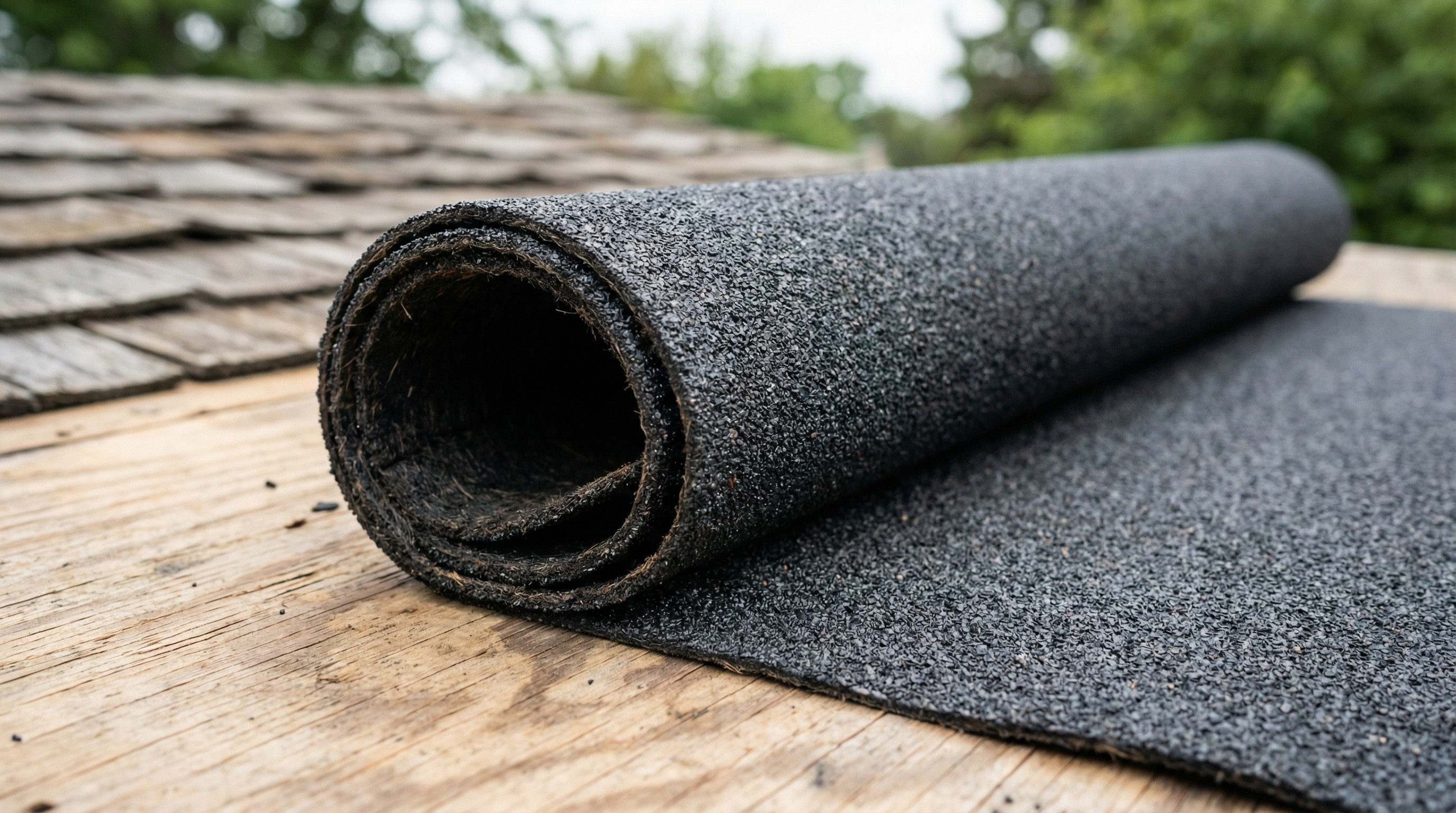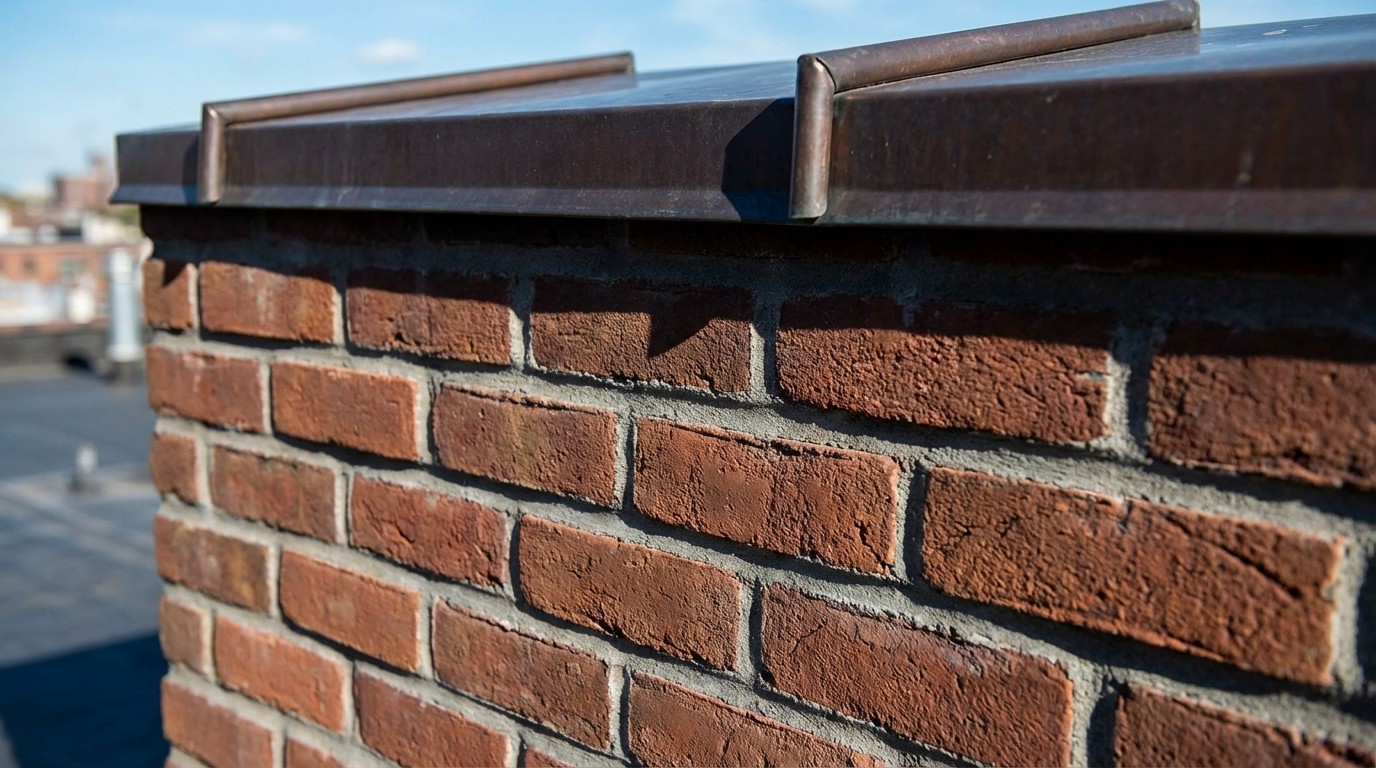Rolled roofing is an asphalt-based material sold in large rolls, designed primarily for low-slope roofs on sheds, garages, and outbuildings. It uses the same basic ingredients as asphalt shingles but comes in wide strips that unroll across the roof deck instead of individual pieces.
We'll walk you through everything you need to know about rolled roofing-the different types available, where it makes sense to use it, what you can expect to pay, and how to tackle installation yourself if you're up for it.
What Is Rolled Roofing
Rolled roofing is an asphalt-based material sold in large rolls that cover about 100 square feet each. It's made from the same ingredients as asphalt shingles, with an asphalt-saturated base and protective mineral granules on top. The difference is the format: instead of individual shingles, you get long strips that unroll across the roof.
This material is designed for low-slope and flat roofs, which is why you'll see it on sheds, detached garages, and covered porches more often than on main homes. The price point makes it attractive for outbuildings where a 25-year roof isn't necessary.
Here's something that trips up a lot of people: rolled roofing is your actual roof surface, not the underlayment that goes beneath other materials. Roofing felt, which looks similar, goes underneath shingles as a secondary water barrier. Rolled roofing goes on top as your actual weatherproofing layer.
Types of Roll Roofing
You'll find four main types of rolled roofing out there, and each one works better for different situations.
Saturated Felt Roll Roofing
Saturated felt is the most basic and cheapest option. It's asphalt-soaked felt without any granule coating on top, which means it has no UV protection. Most roofers use saturated felt as underlayment beneath shingles rather than as a finished roof surface, so if you're looking for something to actually protect your building from the weather, you'll want to keep reading.
Mineral Surface Roll Roofing
Mineral surface roll roofing is what most people mean when they talk about rolled roofing. Ceramic granules cover the top surface, giving it UV resistance and a bit of texture. The granules work the same way they do on shingles, reflecting sunlight and protecting the asphalt from breaking down.
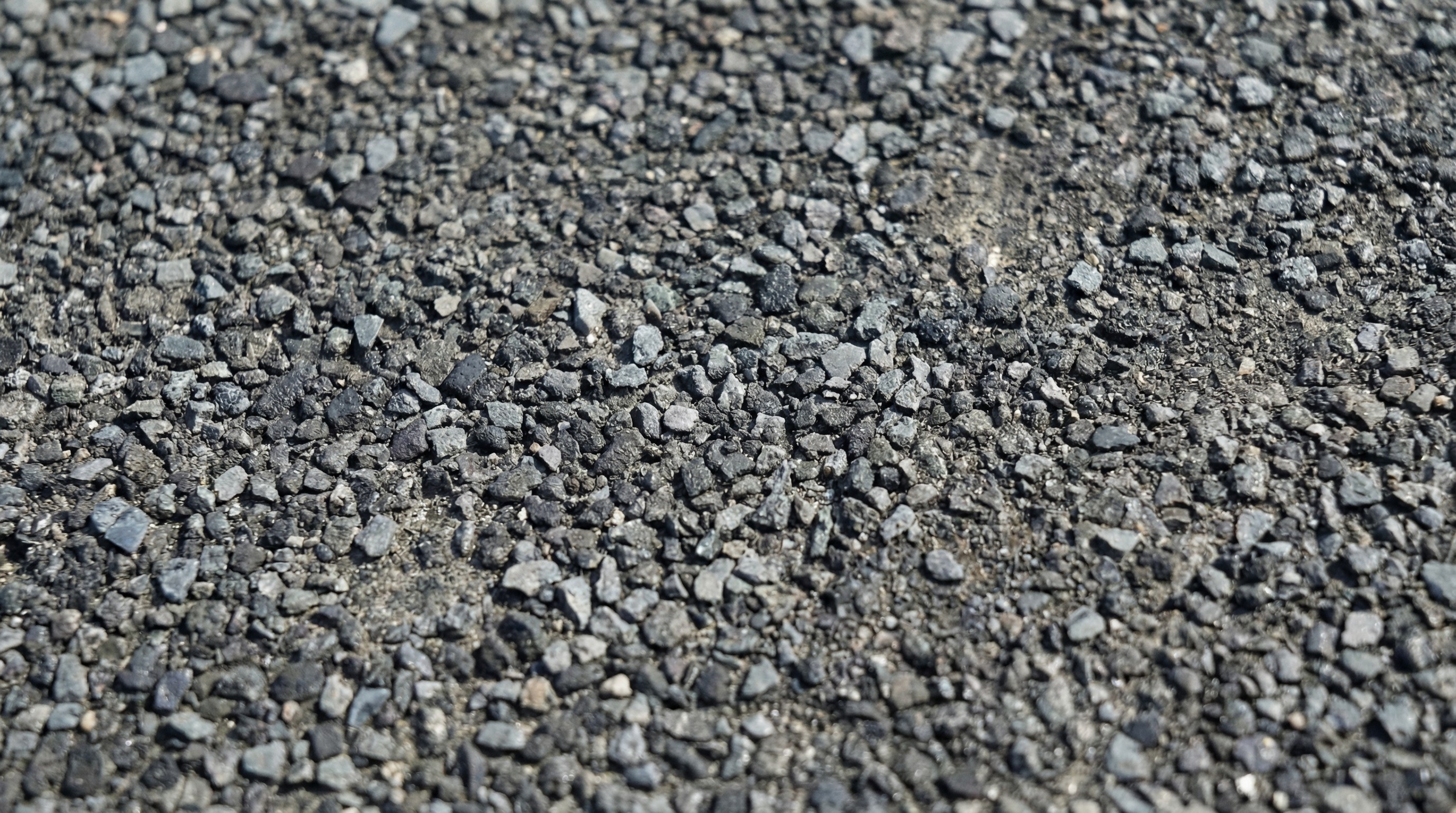
This type comes in a few basic colors, usually black, white, tan, or gray. If you're roofing a shed or garage, mineral surface is likely what you want.
Self-Adhering Rolled Roofing
Self-adhering products have a peel-and-stick backing, so you don't need nails or separate adhesive to install them. The backing bonds directly to the roof deck when you press it down. Installation goes faster, and there's less room for error with nail placement.
The tradeoff is cost. Self-adhering rolls run higher per square foot than standard mineral surface products. For a small shed, the price difference might be worth the easier installation.
Modified Bitumen Membrane Rolls
Modified bitumen is a thicker, more durable rolled material often found on flat commercial roofs. "Bitumen" is just another word for asphalt, and "modified" means the manufacturer added rubber or plastic polymers to improve flexibility and durability.
Installing modified bitumen usually means either using a propane torch to heat-weld the seams or working with special cold adhesives-both of which are better left to the pros for safety reasons.
Where to Use Roll Roofing
Rolled roofing works well in certain situations and poorly in others. Here's where it makes sense.
Sheds and Outbuildings
Storage sheds, workshops, and small barns are the most common places for rolled roofing. The low cost matches the low stakes. If the roof fails in 8 years, replacing it won't break the bank.
Detached Garages and Carports
Standalone garages with low-slope roofs are good candidates, especially if the structure isn't climate-controlled. Carports, which are open on the sides anyway, don't justify expensive roofing materials.
Low-Slope and Flat Roofs
Rolled roofing is specifically engineered for roofs with minimal pitch. A "low-slope" roof has just enough angle to drain water but not enough for traditional shingles to work properly. Shingles rely on gravity and overlap to shed water, and they can fail on nearly flat surfaces. Rolled roofing handles low slopes better because the seams are sealed with adhesive rather than relying on overlap alone.
Covered Porches and Patios
Attached structures like covered porches often have low-slope roofs that tie into the main house. Rolled roofing can work here, though appearance matters more when the roof is visible from the yard or street.
A note on main homes: Rolled roofing is generally not a good fit for primary residences. The shorter lifespan means you'll replace it two or three times in the span of one shingle roof. For a house you plan to live in, the math favors spending more upfront.
How Much does Roll Roofing Cost
Rolled roofing is one of the cheapest roofing options you can buy. Here's what you can realistically expect to pay.
Material Cost per Roll
A single roll covers one "square" in roofing terms, which equals 100 square feet. At most home improvement stores, basic mineral surface rolls run $30 to $50 each. Self-adhering products cost more, typically $50 to $100 per roll depending on the brand and thickness.
For a 200-square-foot shed roof, you'd need two rolls plus some extra for overlap and waste. Material cost alone might land between $80 and $150.
Installed Cost per Square Foot
If you hire a roofer, expect to pay somewhere between $1.50 and $4.00 per square foot for materials and labor combined. Compare that to asphalt shingles, which typically run $3.50 to $7.00 per square foot installed.
Labor costs stay lower with rolled roofing because the installation process is much more straightforward than shingles. Where a roofer might spend a full day carefully laying individual shingles on a small garage, they can roll out the same coverage in just a few hours.
What Affects Roll Roofing Price
Several factors push the price up or down:
Product type: Self-adhering and modified bitumen cost more than standard mineral surface rolls
Roof complexity: Roofs with multiple angles, vents, or skylights take longer to install and use more material at the edges
Tear-off: Removing an old roof before installing new material adds labor cost
Location: Material and labor prices vary by region
How Long does Rolled Roofing Last
Most rolled roofing lasts somewhere between 5 and 15 years. That's a wide range, and where your roof falls depends on a few things.
Sun exposure matters a lot. A south-facing roof in a hot climate will degrade faster than a shaded roof in a mild climate.

Foot traffic also shortens lifespan, so if you're regularly walking on the roof to clean gutters or trim branches, expect more wear.
Ponding water is another factor. On flat roofs, water can pool in low spots instead of draining. Standing water breaks down the asphalt over time and can work its way under seams. Proper installation with good drainage helps, but some ponding is hard to avoid on truly flat surfaces.
For comparison, asphalt shingles typically last 20 to 30 years, and rubber membrane roofs can go 25 to 30 years. Rolled roofing is a budget option, and the lifespan reflects that.
Pros and Cons of Rolled Roofing
Let's break down the real advantages and limitations of rolled roofing so you can make an informed decision.
Pros of Roll Roofing
Low material cost: The cheapest roofing option available at most stores
Fast installation: Covers large areas quickly compared to individual shingles
DIY-friendly: Lightweight rolls are manageable for one or two people
Works on low slopes: Designed for pitches where shingles would fail
Easy to find: Stocked at Home Depot, Lowe's, and most building supply stores
Cons of Roll Roofing
Short lifespan: Plan on replacing it within 5 to 15 years
Basic appearance: Flat, uniform look without the dimension of shingles
Limited colors: Usually just black, white, tan, and gray
Seam vulnerability: Overlaps can leak if not sealed properly
Not for main homes: Most roofers advise against it for primary residences
How to Install Roll Roofing
If you're considering a DIY roofing project, rolled roofing is definitely one of the more manageable options-but it requires careful planning, a solid understanding of roofing principles, and meticulous installation to ensure it holds up over time.
1. Prepare the roof deck
Start with a clean, dry surface. Sweep off debris, pull out old nails, and check for rotted or warped wood. Any soft spots in the deck will telegraph through the roofing and create problems later. Replace damaged sheathing before moving forward.
2. Install drip edge flashing
Drip edge is an L-shaped metal strip that goes along the roof edges. It directs water away from the fascia board and into the gutter. Install drip edge along the eaves first, then along the rakes (the sloped edges on the sides). The rake drip edge overlaps the eave drip edge at the corners.
3. Apply roofing underlayment
Underlayment is a secondary water barrier between the deck and the roofing. While some self-adhering products can go directly on plywood, adding a layer of roofing felt underneath provides extra protection. Roll out the felt horizontally, starting at the bottom edge, and overlap each course by a few inches.
4. Roll out and fasten the roofing
Start at the lowest edge of the roof and work upward. Let the first course overhang the drip edge by about a quarter inch. Overlap each subsequent course by 2 to 4 inches, following the manufacturer's instructions.
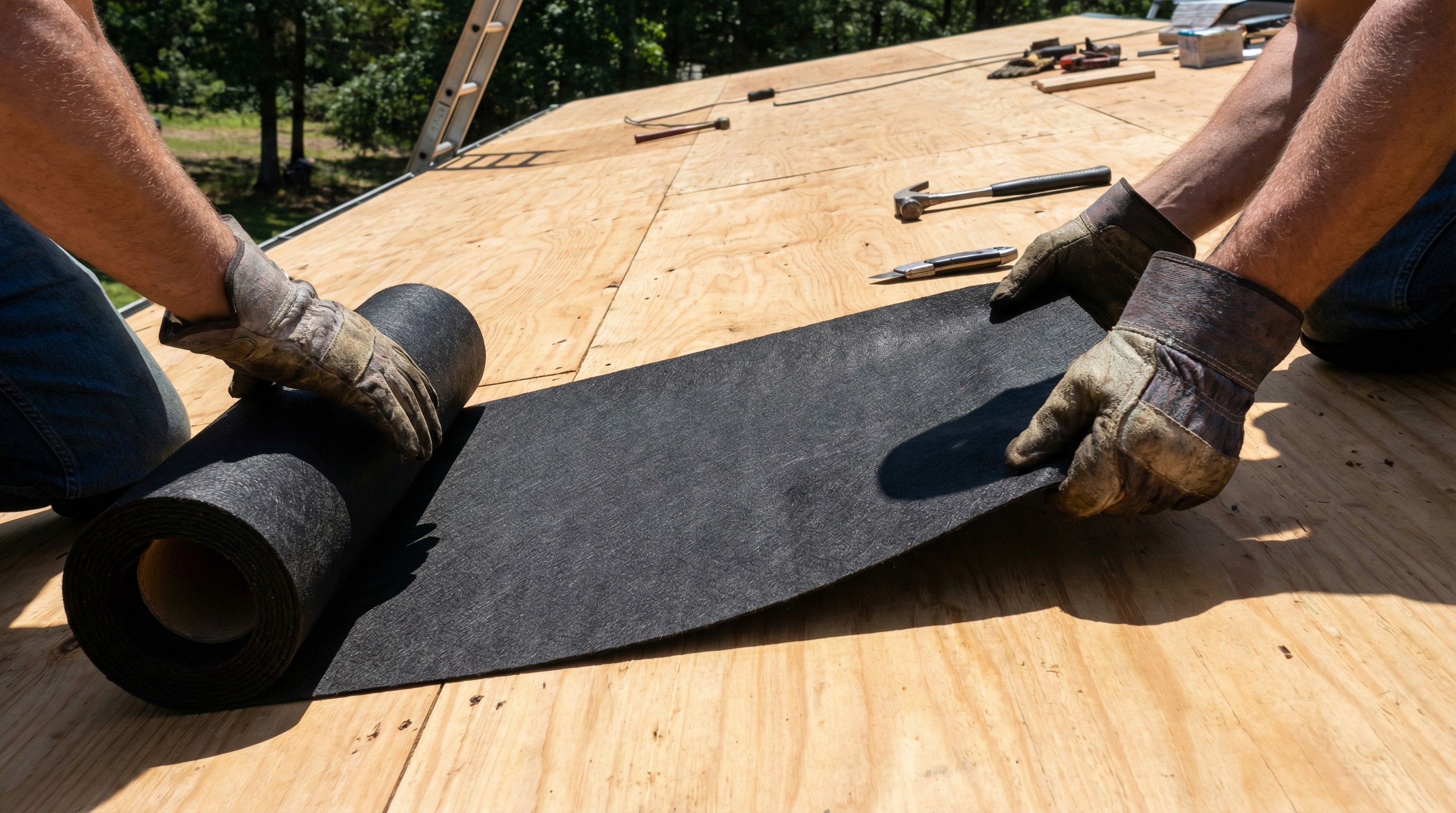
Two fastening methods are common:
Exposed nail method: Drive roofing nails through the overlap, penetrating both layers. Nails are visible but covered by roofing cement.
Concealed nail method: Nail the top edge of each course, then cover the nails with the overlapping course above. Adhesive seals the overlap.
The concealed nail method takes longer but creates fewer potential leak points.
5. Seal all seams and edges
This is the critical step that separates successful DIY installations from ones that develop leaks later. Apply a thick bead of roofing cement under every overlap and press the layers together firmly. Seal around vents, pipes, and any other penetrations. Run a final bead along all edges.
Roofing cement stays flexible and waterproof for years, but only if you apply enough. Thin, skimpy seams will eventually let water through.
When to Hire a Professional Roofer Instead of DIY
DIY installation makes sense for small, simple projects. Larger or more complicated roofs often justify professional help.
Steep or high roofs: Falls are the leading cause of DIY roofing injuries. If you're uncomfortable with heights or don't have proper safety equipment, hire someone.
Complex roof shapes: Valleys, dormers, and multiple penetrations require careful flashing work. Mistakes here cause leaks.
Structural concerns: If the roof deck feels soft or bouncy, a professional can assess whether the underlying structure is sound.
Warranty requirements: Some roofing products require professional installation for the warranty to apply.
Rolled Roofing vs Other Flat Roof Materials
Rolled roofing isn't the only option for low-slope and flat roofs. Here's how it compares to alternatives.
Material | Typical Cost | Expected Lifespan | DIY Friendly | Best Use |
|---|---|---|---|---|
Roll roofing | $1.50-$4.00/sq ft | 5-15 years | Yes | Sheds, outbuildings |
Asphalt shingles | $3.50-$7.00/sq ft | 20-30 years | Somewhat | Sloped main roofs |
TPO membrane | $5.00-$10.00/sq ft | 20-30 years | No | Flat commercial and residential |
EPDM rubber | $4.00-$8.00/sq ft | 25-30 years | Somewhat | Flat roofs needing durability |
Rolled Roofing vs Asphalt Shingles
Shingles cost more and last longer. They also look better, with dimensional profiles that add curb appeal. However, shingles require a steeper pitch to function properly. On a low-slope roof, shingles can allow water to back up under the tabs and cause leaks. For main homes with adequate slope, shingles are almost always the better investment.
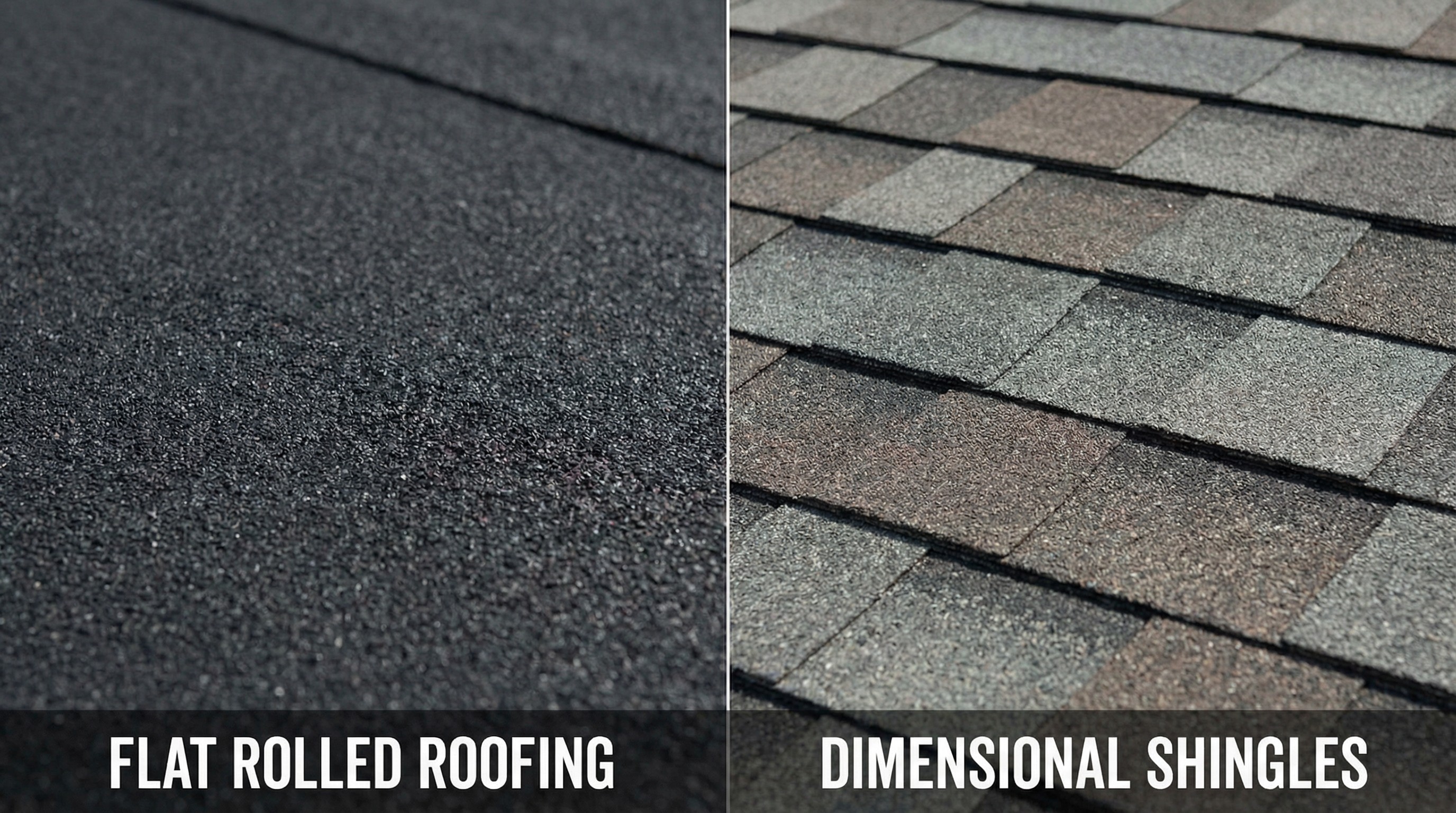
Rolled Roofing vs TPO Membrane
TPO is a single-ply white membrane commonly used on flat commercial roofs. It reflects sunlight well, which can reduce cooling costs. Installation requires heat-welding the seams with specialized equipment, so professional installation is standard. TPO costs more upfront but lasts significantly longer than rolled roofing.
Rolled Roofing vs EPDM Rubber Roofing
EPDM is a synthetic rubber membrane known for durability and flexibility. It handles temperature swings well and resists UV damage. EPDM comes in large sheets that minimize seams, reducing leak potential. For a flat roof on an occupied building, like a home addition or finished garage, EPDM often makes more sense despite the higher cost.

